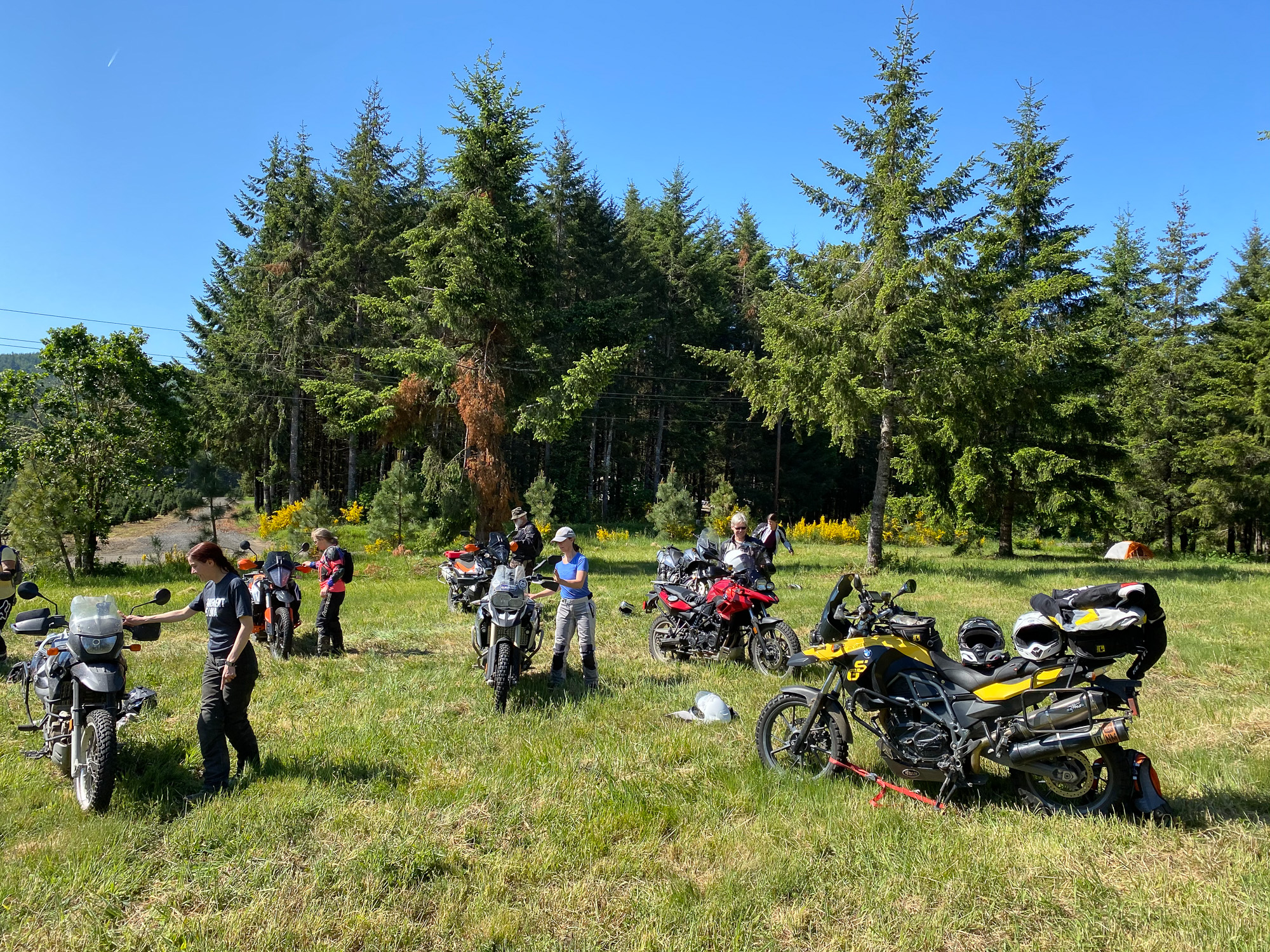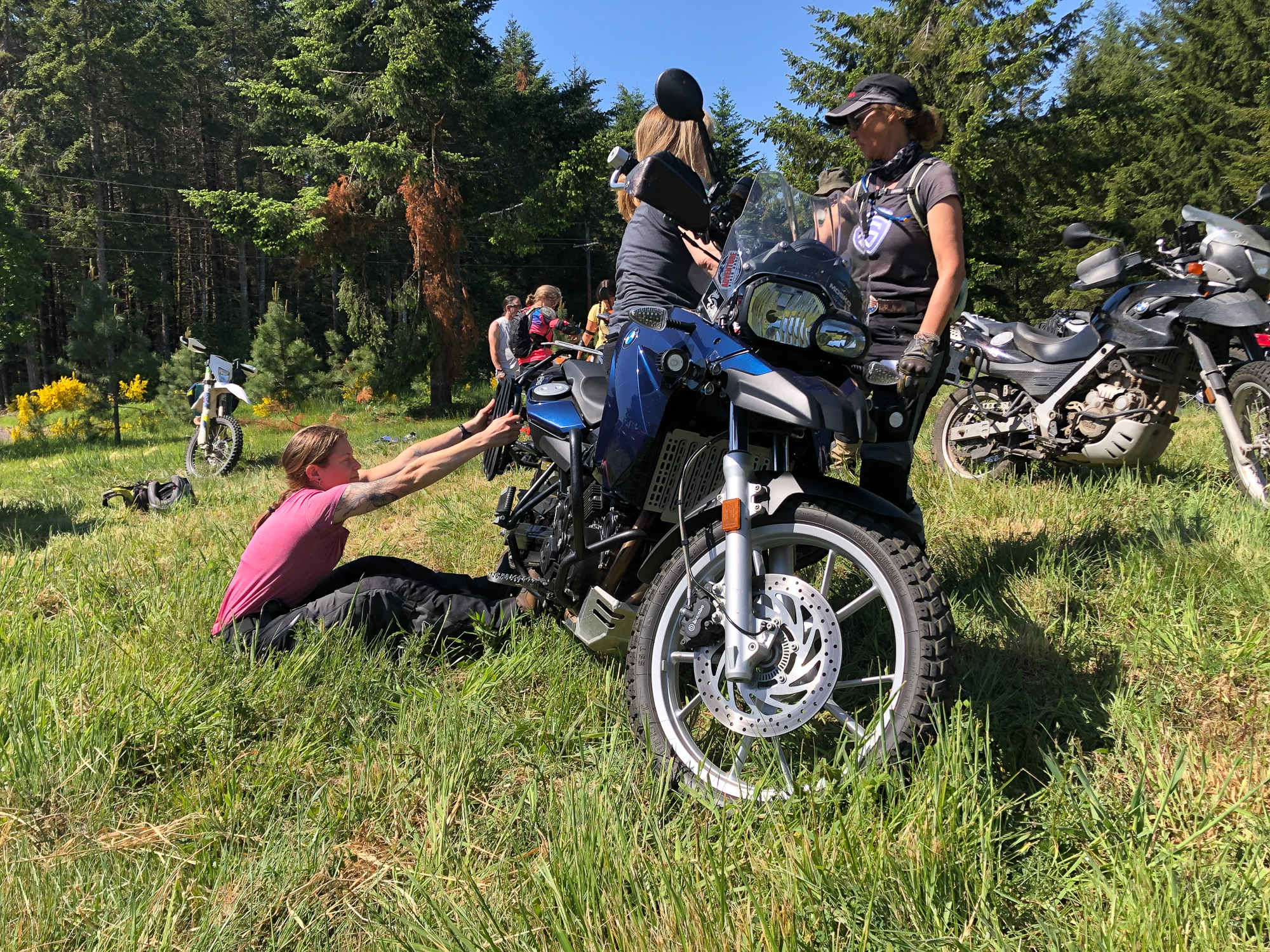I’ll admit that after 708 days riding around the world, my first thought was, what could I possibly learn in a Level 1 off-road course? I’d spent two years swerving around stray dogs and potholes, hopping my fully loaded F 800 GS up mountain roads, and throttling through countless creek crossings—what would weaving between orange cones teach me now? Deep down, I knew I could be a stronger off-roader, but I’ve always been the kind of person who preferred to learn “on the job.” I figured with practice, I’d get better.
While traveling, I’d honed my riding skills daily, but after returning home, I was only going out a few times a year to ride BDRs or gallivant around town on pavement doing errands. My dirt skills would not improve this way, so in May—three and a half years after I got back from traveling—I signed up for SheADV’s Level 1/2 off-road course, endorsed by Dragoo Adventure Rider Training.
One aspect that attracted me to this course was that, if nothing else, I might meet other riders. The style of riding I enjoy is not conducive to meeting female riding partners. Why is that? It’s not because we can’t touch the ground with both toes or that ADV riding is “hard”—five-foot-one Jocelin Snow proves all of that wrong. And let’s not forget there are short male riders, too.
No, one of my biggest struggles as an ADV rider is I’m surrounded by men—namely, my husband and his friends. This usually leaves me feeling like I’m in over my head. Off-highway moto exploring, however, is one of my favorite things to do; that’s why I learned to ride in the first place, even if ADV riding sometimes makes me nervous.
I love my husband, and we’ve had some incredible experiences together on two wheels, but I’ve always wondered: would I ride better in a patient, supportive environment specific to learning? One where dropping my bike several times a day is okay and even expected? Or where I could try a challenging section over and over, instead of just praying to get through it?

I loved the idea of meeting other female ADV riders at a training course.
On a sunny May morning, I loaded my F 800 GS and left my home in Bellingham, Washington, en route to Monmouth, Oregon, where the training was happening.
“I’m going to ride motorcycles in the dirt,” I said to my husband. “Water the garden while I’m gone, please!”
It was the first time in our seven years together that I was the one going off on a motorcycle trip instead of or without Dave. That thought alone put an extra twist in my throttle and a smile (or was it a smirk?) on my face. For the next five days, I’d travel at my own pace and make my own choices.
When I arrived in Monmouth later that evening, I found where the course was being held, noticing tents set up on either side of a short gravel road. Doing a quick scan of the area, I thought, Where’s the training ground? This looks too easy. I turned onto a large grassy area where three people sat by tents and waved to me in welcome. The uneven, lumpy ground caught me off guard and I bounced over to a flat spot for my tent, hoping I wasn’t about to crater my bike in front of everyone.

Camping at the training course kept this trip economical.
After setting up camp, I wandered to the main area to meet the other 13 participants. There was a father-daughter team, a father-daughter-husband team, and another man who’d joined a female friend. The rest were all women on big bikes. I was relieved to see I wasn’t the only one with a heavy steed.
Day 1
In the morning, I saw the training course being set up on the bumpy, off-camber hill I’d almost dropped my bike on upon entry. In fact, I had dropped it when I tried to move it closer to my tent. This wouldn’t be easy ground to ride over. Throw in tight cornering and slow speeds, and things were about to get interesting.

SheADV instructor, Shalmarie Wilson, setting up the course.

A common occurrence on the lumpy ground.
Our highly accomplished, knowledgeable instructor, Shalmarie Wilson, laid out the first task of the morning: Simon Says. We followed her skilled assistant, Kris Fant, in circles going uphill at slow speeds while putting a left hand on our heads and hooking a foot behind us on our seats. This was tricky! My friction zone—that sweet-spot management of the clutch and throttle—wanted to stall and send me sprawling a few times.

Instructor, Shalmarie Wilson of SheADV.com
Next, we had to weave up and down the hill between tightly spaced pylons while also dabbing a foot down at each one—without falling or stalling. If that doesn’t sound tough enough, try doing it while standing on the pegs.

The stop-and-start section.
These exercises and others were for discovering the balancing point of our bikes and how to gain control in nonideal circumstances. Flicking up kickstands, we were asked to take one finger—two at most—to balance the bike while walking in a circle. A few bikes toppled over, giving us opportunities to try out the Monkey Lift, where one person grabs the handlebars and frame or rack, shoving their butt into the seat. Another gets hold of the frame or rack on the other side, stands on the rear wheel, then sits, cantilevering. This was a valuable skill for me to learn; although the Monkey Lift requires two people, I could now have a more active role in lifting my bike. Plus, the two-person technique would save energy if I was out with my husband or another riding partner where bike drops might be common. I’m able to pick up my GS, even fully loaded, but in terrain where the bike might go down more often, multiple solo re-rights were too exhausting.

One-finger balancing skill section. The orange strap on Shalmarie’s bike is a great method for ensuring your front wheel doesn’t ‘walk’ while on the center stand.



Besty and Deanna demonstrate the Moneky Lift.
Day 2
The training difficulty increased on the second day for Level 2. We practiced stopping on a steep, grassy hill by dumping the clutch (no brakes), using only our right foot and careful clutching to back the bike down to a flatter spot. My favorite part of this practice was learning how to wiggle the handlebars left, right, left, right in order to turn and straighten out the front wheel without too much effort.
Hard stops in gravel followed; here, we practiced skidding with control of the front wheel, managing the slide with proper braking and body positioning. On the same road section, we were instructed to take off without spinning the rear tire. I thought back to countless times on my RTW trip where this kind of control would have come in handy.

Shlamarie explains hard stops in gravel.

A great spot for carrying a tow rope.
One of the most noteworthy revelations I had that weekend, however, was learning what I was good at. If like me, you only take courses to educate yourself on what you don’t know, you’re doing yourself a disservice. Knowing where your strengths lie is just as important, and sometimes, we don’t give ourselves the opportunity to test this out. For example, I’d avoided riding to the porta potty as it meant doing a tight U-turn in gravel to get back. Instead, I walked the 200 meters or so. Not a big deal unless you’re well-hydrated in the 78°F heat and have to pee 10 times a day. After doing a series of tight cornering in a figure-eight sequence on the training ground, I discovered I was actually quite competent at making tight turns. I could’ve been riding up to the bathroom like all the cool kids all this time!


Tight cornering skills section.

Oops. Even the experts need help sometimes. Shalmarie trying to bend her clutch back into place after hooking her riding boot and dropping the bike.
In another exercise, we stood beside our running bikes and, using the friction zone only, throttled them up the road, turning between two cones, where we had to rock them back and forth without using any brakes. I was sure I wouldn’t be able to reach the throttle with my short arms, but I could, which made me realize that using this method, I could load my GS onto a trailer.
If At First You Don’t Succeed
Attempting the same challenge over and over again is another advantage of being in a course. No one’s waiting impatiently when you don’t get it the first time and want to go back. You’re surrounded by participants who are all in the same boat, failing and trying again. And everyone’s more than happy to encourage you to take another shot on that scary uphill climb or the figure-eights that continue to wash out your rear tire.


Making repeated attempts helps you see yourself improve, all while there’s a certified instructor right there telling you what you’re doing or not doing and how you can make it easier.
I Wish I Knew That Before Riding Around the World
Taking the SheADV course helped me not be afraid of my bike and to understand what I was keeping myself from. The Monkey Lift would’ve saved Dave and me a ton of energy on what were already long, exhausting days during our travels. The balance point on my GS is clearer now, as well as my body positioning.

A participant shows good body positioning while cornering.
A key finding I wish I’d known before my long-distance travels was that my wrists have too much bend in them while sitting. I came back from that two-year ride with significant wrist problems that plague me to this day. Proper body positioning while standing and sitting was another course perk that could have saved me from joint pain.
You’ll Learn From Other Students, Too
One participant, Betsy, gets huge points for showing me how to get on and off a bike when you can’t put the kickstand down. Again, this would’ve saved me energy and frustration whenever I parked somewhere with too much angle, or for getting on a taller bike. It’s tougher when you have gear on the pillion seat, but it can still be done.
Recently, I got on and rode my husband’s Husqvarna 300 using this technique. Because it’s too tall for me to get a toe down, I’ve never even tried to get it off the side stand. Now I can.
I found the other students to be a wealth of information. A woman named Jenny is starting a motorcycle apparel business, which I’m excited about, having had a hard time finding gear to fit me. I learned about the Unrally. I found out I can buy moto skivvies for my sore butt. These gatherings are a great place to see what other riders use, like, and don’t like.

Evening discussions and getting to know the other riders was also an ideal time to learn more.
Would I Take Off-road Training Again?
Heck, yes. I left Monmouth with more confidence in my bike and myself as a rider, but that doesn’t mean I’m done. I still have a lot to learn, and I’d like to advance my skills on more difficult terrain.

I’ve already signed up for another one of Shalmarie’s courses coming up in September at the Touratech West Rally.
Will I see you there?




Our No Compromise Clause: We carefully screen all contributors to make sure they are independent and impartial. We never have and never will accept advertorial, and we do not allow advertising to influence our product or destination reviews.


